Speaking Trees and Holy Trees
In ancient Mesopotamia, statues of gods and goddesses were carved out of WOOD, a living substance. Priests carried these wooden deities to the river where a mouth-washing ritual (like baptism) was performed to make them come alive and SPEAK. The statues were then carried to the temple and worshipped as rulers of their respective cities. It was the duty of the priesthood to converse with the deity and relay messages to the "constituents," the worshippers.
Deities had trees assigned to them. So when people sat under the god’s tree, they believed that they could "speak out" and the god would, hopefully, "reply." Orchards were special places. The belief that spirits dwell in trees is worldwide. Among many clans trees are regarded as ancestors of the tribe (totems) or as the abode of spirits or souls that enter the womb to become babies. Sacred trees are felled only after purification ceremonies. There were tree-planting ceremonies at: betrothals, marriages, ascent to a throne, a newborn child, etc.
The Torah, the Old Testament, mentions several Holy trees. Psalm 137: (Populus euphratica): By the rivers of Babylon … there on the poplars we hung our harps.
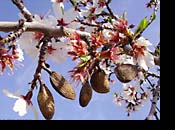
 Abraham and Isaac are associated with the Tamarisk gallica, common in the Sinai (Beersheba): a shrub up to 15 feet high with clusters of tiny pink flowers. The sap (honey-like material) was known as "manna" and considered a great delicacy. And famous oaks were at Shechem and Hebron. Aaron, brother of Moses, had a wooden staff made from (Prunus amygdalus) the almond tree that turned into a snake when he threw it down at Pharaoh’s court. The almond tree is of the order Rosales; the peach and apple are closely related; so is the pistachio, the green almond tree.
Abraham and Isaac are associated with the Tamarisk gallica, common in the Sinai (Beersheba): a shrub up to 15 feet high with clusters of tiny pink flowers. The sap (honey-like material) was known as "manna" and considered a great delicacy. And famous oaks were at Shechem and Hebron. Aaron, brother of Moses, had a wooden staff made from (Prunus amygdalus) the almond tree that turned into a snake when he threw it down at Pharaoh’s court. The almond tree is of the order Rosales; the peach and apple are closely related; so is the pistachio, the green almond tree.
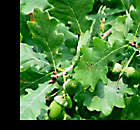 The Holy Oak tree: quercus The "oracular oak" of Dodona in Greece was tended by priests who listened to the cooing of doves, the voice of the god Zeus. Tall oaks were oracles inhabited by gods, who gave the responses; according to ancient North Germans. The high priest was called "God’s mouth." The great oak of Jupiter was in Hesse, Germany.
The Holy Oak tree: quercus The "oracular oak" of Dodona in Greece was tended by priests who listened to the cooing of doves, the voice of the god Zeus. Tall oaks were oracles inhabited by gods, who gave the responses; according to ancient North Germans. The high priest was called "God’s mouth." The great oak of Jupiter was in Hesse, Germany.
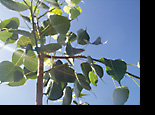 The Holy Bodhi tree, ficus religiosa, grows in India. It is evergreen, but renews its foliage once a year at the end of the rainy season. All the leaves will drop, and then regrow in just two weeks, creating a natural symbol of reincarnation. It was under one of these trees in the village of Godh Gaya that the Buddha attained enlightenment 2,500 years ago. Tying yellow or orange strips of cloth around its trunk is a sign of respect for the teachings of Buddha. Anuradhapura, Sri Lanka, is a pilgrimage place where Buddhists worship the bo tree.
The Holy Bodhi tree, ficus religiosa, grows in India. It is evergreen, but renews its foliage once a year at the end of the rainy season. All the leaves will drop, and then regrow in just two weeks, creating a natural symbol of reincarnation. It was under one of these trees in the village of Godh Gaya that the Buddha attained enlightenment 2,500 years ago. Tying yellow or orange strips of cloth around its trunk is a sign of respect for the teachings of Buddha. Anuradhapura, Sri Lanka, is a pilgrimage place where Buddhists worship the bo tree.
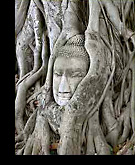 The Christmas tree, an evergreen conifer, originally was chosen by the pagans as their symbol for eternal life, as green is a sacred color. Christianity adopted this tree as a symbol for eternal life in Christ. During Victorian times, people started to decorate their trees with candies and cookies and much later with ornaments.
The Christmas tree, an evergreen conifer, originally was chosen by the pagans as their symbol for eternal life, as green is a sacred color. Christianity adopted this tree as a symbol for eternal life in Christ. During Victorian times, people started to decorate their trees with candies and cookies and much later with ornaments.
The Family tree: Royal houses had "family trees" (genealogy). According to the Christian New Testament, Jesus of Nazareth was a descendant of King David. Nowadays, common people like knowing about their ancestors and are researching about their "roots".
 The Pomegranate Tree: In ancient Greece / Rome, pomegranates were the sacred food of the underworld goddess Persephone / Kore.
The Pomegranate Tree: In ancient Greece / Rome, pomegranates were the sacred food of the underworld goddess Persephone / Kore.
In Jerusalem, Jewish priests wore a tunic and from its hem hung pomegranates alternated with gold bells that rang so the priests would not die when they entered the Temple and when they came out (Exodus 28:33-35).
Pomegranates decorated the capitals on top of the pillars of the Temple (1 Kings 7:42).

Pomegranate tile
Thanks to the
London Transport Museum
The Grape Vine: According to the Jewish Torah (Christian Old Testament), Noah and his family were the sole survivors of the flood that destroyed the world. After Noah gave thanks to his Lord, he planted a vineyard (Genesis 9:20).
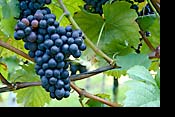 The Golden Vine in the Temple of Jerusalem: Tacitus mentioned the Golden Vine that stood over the entrance of the sanctuary in his description of the taking of Jerusalem in 63 BCE by the Roman army. Josephus wrote in his The Jewish War that large grape-clusters hung over the trained posts of the Golden Vine. The priests would stand in front of the Golden Vine and recite the Priestly Blessing.
The Golden Vine in the Temple of Jerusalem: Tacitus mentioned the Golden Vine that stood over the entrance of the sanctuary in his description of the taking of Jerusalem in 63 BCE by the Roman army. Josephus wrote in his The Jewish War that large grape-clusters hung over the trained posts of the Golden Vine. The priests would stand in front of the Golden Vine and recite the Priestly Blessing.
In ancient Greece, the god Dionysos was the god of the vine and Romans worshipped the vine god Bacchus. The splendor of truth in wine, "In vino veritas," became their salutation.
In the New Testament Gospel of John (15:1), Jesus said: I am the true vine.
Muslims do not tend vineyards. However, in their Paradise flow four rivers and one of them has delectable wine; the others offer water, milk, and honey (Koran. Sura 47:15).
 Camellia Tree (japonica): a genus of more than 80 species of broad-leaved evergreen trees and shrubs belonging to the tea family (Theaceae) and native to Asia. Foliage: shiny dark green; flowers: single, semi-double and complete double; colors: white, rose, red or variegated. Camellia japonica flowers in winter whereas camellia sasanqua flowers in the fall. They can reach up to 30 feet in height. Culture: cool, acid-loving. I add left over black coffee to the watering can and the flowers thank me. When the soil is dry, camellia buds shrivel and drop. They are propagated from seeds to secure new varieties and to furnish stocks for grafting / cuttings.
Camellia Tree (japonica): a genus of more than 80 species of broad-leaved evergreen trees and shrubs belonging to the tea family (Theaceae) and native to Asia. Foliage: shiny dark green; flowers: single, semi-double and complete double; colors: white, rose, red or variegated. Camellia japonica flowers in winter whereas camellia sasanqua flowers in the fall. They can reach up to 30 feet in height. Culture: cool, acid-loving. I add left over black coffee to the watering can and the flowers thank me. When the soil is dry, camellia buds shrivel and drop. They are propagated from seeds to secure new varieties and to furnish stocks for grafting / cuttings.
In the late 17th century, the Moravian missionary George Joseph Kamel (Camellus) discovered the camellia in the Philippines and they were taken to London, Vienna, and Dresden in the late 18th century. After 1870, the camellia became "en vogue" when women wore the flowers in their hair, as corsages, and in bridal bouquets. The Parisian courtesan Marie Duplessis (who died at age 22) was known for her passion for white camellias. She was courted by Dumas, who made her famous in his novel La Dame aux Camélias. Queen Mother Elizabeth of England was fond of camellias and, when in season, had bouquets in every color.
